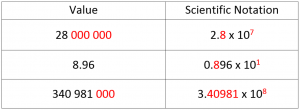What I’ve learned last week on Math 10 was Scientific Notation.
Scientific Notation is another way of writing numbers that is either too small or too large to write. Scientific notation is simplified and more convenient.
Scientific notation can only be written in form: a • 10n
Whereas a is a coefficient that is greater than or equal to 1 but less than 10.
1 ≤ a < 10.
The exponent (n), represents how many times do you need to multiply the 10 so you can reach the exact value you’re looking for. The value of your exponent is based on how many your zeros is and how many decimals are added. If you already have a decimal value, you don’t add it to your exponent.
For example, you have 48 000. To get the scientific notation form of 48 000, you need to get the coefficient, and the exponent.
Coefficient = 4.8; It is 4.8 and not 48 because you need to have a greater number or equal to one but less than ten.
Exponent = 4; It is four (4) and not three (3) because you have a decimal in your coefficient.
4.8 • 104 = 48 000.
In other words, the exponent corresponds not only to the number of zeros (0’s) you have but also how many decimals are added.

